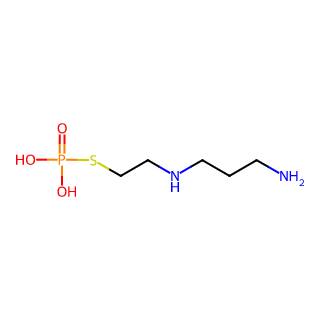- Synthetic anti-infective drugs
- Medications for the digestive system
- Antipyretic and analgesic drugs
- Medications for the blood system
- Medications for the respiratory system
- Anti-allergic drugs
- Medications for the urinary system
- Diagnostic medications
- Immunosuppressive and immunomodulatory drugs
- Vitamins and mineral supplements
- Antioxidants and medications for osteoporosis
- Antiparasitic drugs
- Ophthalmic medications
- Amino acids and their derivatives
- Dermatological medications
- Medications for the circulatory system
- Antitumor drugs
- Medications for the nervous system
- Hormonal and endocrine function-regulating drugs
- Antibiotics
- Others
CAS Number: 20537-88-6




Basic Information
Product Name: Amifostine
Synonyms: Ethyol, WR-2721, Gammaphos, S-2-[3-Aminopropylamine]ethyl hydrogen phosphorothioate
CAS Number: 20537-88-6
Chemical Formula: C5H15N2O3PS
Molecular Weight: 214.22 g/mol (or 325.4242 g/mol depending on the source, note the difference may be due to different states or isoforms)
Physical Properties
Appearance: White solid or crystalline powder
Melting Point: 160-161°C
Boiling Point: 441.7°C at 760 mmHg
Flash Point: 220.9°C (or 220.9±30.4°C depending on the source)
Density: 1.367 g/cm³ (or 1.4±0.1 g/cm³ depending on the source)
Solubility: Easily soluble in water, solubility may vary with conditions such as temperature and pressure.
Chemical Properties
Stability: Stable under normal conditions, but should be stored in a cool, dry place away from light.
pH Value: Not specifically mentioned, but as a phosphate compound, it may affect the pH of solutions when dissolved.
Reactivity: May react with strong oxidants or acids, resulting in decomposition or other chemical changes.
Biological Activity
Mechanism of Action: Amifostine is a broad-spectrum cell protector and radiation protector. It works by selectively protecting normal tissues from damage caused by radiotherapy and chemotherapy. It is also an effective HIF-α1 and p53 inducer, which can reduce renal toxicity and have anti-angiogenic effects.
Pharmacodynamics: After intravenous administration, Amifostine is rapidly metabolized and distributed in the body. It reaches maximum blood concentration within a short period of time and is quickly eliminated from the body.
Applications
Therapeutic Use: Amifostine is used as an adjuvant drug in the treatment of various cancers, such as lung cancer, ovarian cancer, breast cancer, nasopharyngeal cancer, bone tumors, gastrointestinal tumors, and hematological tumors. It can significantly reduce the toxicity of chemotherapy drugs to the kidneys, bone marrow, heart, ears, and nervous system without reducing the efficacy of the chemotherapy drugs. It can also significantly reduce the occurrence of oral dryness and mucositis in patients undergoing radiotherapy.
Research Use: Amifostine is also used in scientific research for studying its mechanisms of action, protective effects on normal tissues, and interactions with other drugs.

Tai Yau Street, San Po Kong, Kowloon, Hong Kong, China.



